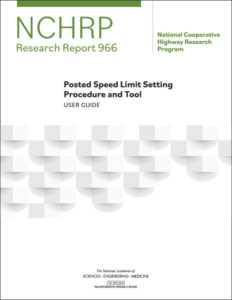 Texas A&M Transportation Institute (TTI) Senior Research Engineer Kay Fitzpatrick led the team that wrote the recently published National Cooperative Highway Research Program (NCHRP) Research Report 966, Posted Speed Limit Setting Procedure and Tool: User Guide. Fitzpatrick’s co-authors include Subasish Das, associate research scientist, and Michael P. Pratt, assistant research engineer, both in TTI’s Roadway Safety Division; Karen Dixon, senior research engineer in TTI’s Traffic Operations and Roadway Safety Division; and Tim Gates, professor at Michigan State University.
Texas A&M Transportation Institute (TTI) Senior Research Engineer Kay Fitzpatrick led the team that wrote the recently published National Cooperative Highway Research Program (NCHRP) Research Report 966, Posted Speed Limit Setting Procedure and Tool: User Guide. Fitzpatrick’s co-authors include Subasish Das, associate research scientist, and Michael P. Pratt, assistant research engineer, both in TTI’s Roadway Safety Division; Karen Dixon, senior research engineer in TTI’s Traffic Operations and Roadway Safety Division; and Tim Gates, professor at Michigan State University.
Several engineering factors are considered when determining a posted speed limit, including the 85th percentile speed, which is based on the driving behavior of most drivers. This percentile speed is believed to represent a speed that would minimize crashes. The report provides and explains a Speed Limit Setting Procedure (SLS-Procedure) that considers factors beyond the 85th percentile speed, including driver-speed choice and safety associated with the roadway to help engineers make informed decisions about the setting of speed limits. The report also provides instructions for using an automated version of the SLS-Procedure via a spreadsheet-based Speed Limit Setting Tool (SLS-Tool), where users input data for a roadway segment and obtain the suggested speed limit.
“The SLS-Procedure was automated with the SLS-Tool using spreadsheet-based software,” says Fitzpatrick. “The development of the SLS-Tool provides an easy-to-use, intuitive spreadsheet that produces a suggested speed limit reflecting existing conditions. It can also document the conditions for a speed-zone study.”
Interest in the methodology for how speed limits are set is growing in many cities and states that have adopted Vision Zero, an international road traffic safety initiative that aims to achieve no fatalities or serious injuries on roadways. Although several factors influence a driver’s chosen speed, posted speed limits is one of those items. The new SLS-Tool is more sensitive to roadway characteristics and pedestrian and bicyclist activities occurring uniquely within the urban environment.
“The SLS-Procedure and accompanying SLS-Tool reflect current knowledge of relationships among roadway conditions, traffic, safety and operating speeds,” explains Fitzpatrick. “While it represents a step forward with respect to previously available methodologies, the SLS-Tool needs to be kept up-to-date as we learn more about the interconnectivity of those factors.”
The user guide is accompanied by the NCHRP’s NCHRP Web-Only Document 291: Development of a Posted Speed Limit Setting Procedure and Tool, which documents the research efforts of NCHRP Project 17-76. A macro version of the SLS-Tool and a no-macro version are available for download on the NCHRP website.